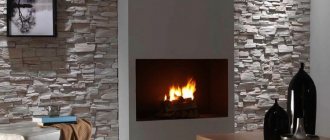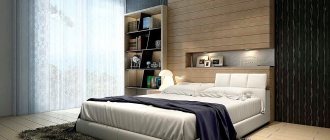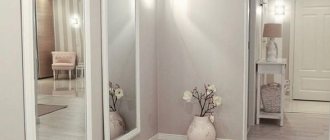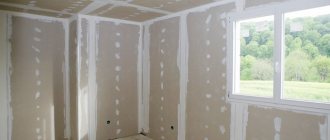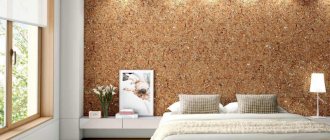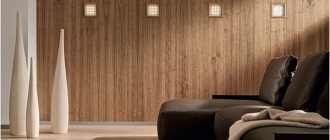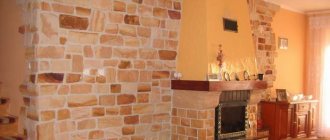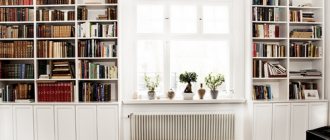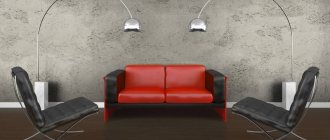In this article we will talk about how you can decorate the walls in the living room, what their design is based on and how to combine colors and textures if the owners of the apartment have different tastes.
When entering a house, or any room, the first thing your gaze falls on is the walls of the room. Their design should reflect the aesthetics of the owners of the house. From the walls you can judge what effect is inherent in the design, what is emphasized and what emotions should be conveyed to the people in the living room.
Wall design options in the living room
How can you decorate the walls? Let's look at the main options for their design.
1. Decorative plaster. A material that will help create a unique wall decor. Using a roller or spatula, you can create entire paintings and panels. Even the simplest brushstrokes will look like a work of art. Previously, this wall design was mainly found in loft or country styles, but now plastered walls fit harmoniously into any other style.
On the building materials market you can find different types of plaster for all repair cases. And special attachments for rollers, with which you can decorate the wall to suit every taste. The advantage of this finishing method is durability , since plaster can last for decades.
2. Paint. Painting seems to be one of the easiest types of wall design, but this is only at first glance. And if the painting process itself can be entrusted even to an inexperienced painter, then the preparation and choice of material should be carefully considered.
For each room, a separate type of paint is selected, the composition and its qualities are studied. The paint should be harmless, without strong odors and dry well.
The disadvantage of painting is that the layers of paint are thin, so they will not hide obvious defects in the walls. You should choose it after studying the properties of different types, remembering that:
- not all types of paint tolerate water well (this point should be taken into account already at the rough finishing stage);
- some types may fade and fade , so for rooms with good natural light it is better to choose UV-resistant paint;
- Many enamels may develop a yellow tint over time and must be periodically renewed;
- There is paint that has a strong odor and takes a long time to dry. In such cases (if this is not the first renovation in the apartment), it is better to remove all things and furniture so that they do not become saturated with an unpleasant aroma.
A wide variety of paint types will allow you to create a unique design. This is the brightest, fastest and most economical way.
3. Wallpaper. The most popular type of wall decoration in the living room. Paper wallpaper is also considered the best “breathable” material for decorating living rooms. Every year their quality gets better, and a variety of textures, colors and designs will attract the attention of any guest.
The most common wallpaper materials for the living room:
- paper;
- textile;
- vinyl;
- liquid;
- photo wallpaper.
The texture can be smooth, embossed or embossed.
4. Decorative masonry. Often in the interior of the living room you can find one (or even all) walls that are lined with brick or stone. This design claims a certain exclusivity.
In order for the design to look advantageous, you need to remember about good lighting; stone and brick “eat up” the light.
Decorative masonry goes very well with other wall decoration materials.
5. Decorative panels are panels that imitate different wall finishing materials. They are made from artificial and organic raw materials, the choice is huge and varied in color and texture. And the main advantage of the panels is that they are easy to install. They perfectly hide uneven walls, cover communications and decorate the space.
6. Painting. Adds some artistic flair to the interior. But the advantage of this wall design is not only the aesthetic side. Thanks to certain types of painting, you can visually enlarge a room, play up a set of furniture, emphasize the wall and delimit the space into zones. Any drawing carries a message and a charge of a certain mood in the living room, so often the rest of the interior is matched to the painting, and not vice versa.
Main types of painting:
- artistic - frescoes, stained glass, still lifes, portraits and various complex paintings;
- airbrush;
- lettering and chalk drawings;
- 3D painting is the best type for adding volume and airiness to the space;
- images using stencils and stamps - a technique that even a beginner can handle;
- decoupage and stickers.
Which wall to place the TV on?
The best place to install a TV is where the screen is located at the optimal distance from the audience. For devices with a 32" diagonal, it should be placed at a distance of at least 1.5 m. For a 40" screen - 1.6-1.7 m. If the TV has a 60" diagonal, it should be installed at least 2.5 m from the sofa.
In a small living room, it is better to place the TV against a short wall at a height of 1-1.5 m. It is better if it is located opposite the window. It is worth choosing a perpendicular position of the screen to the window if there is enough space in the room and the windows are covered with thick curtains.
A TV in the most illuminated area is a good solution
Options for placing a TV against the wall in the living room:
- On the bracket. It's better to choose a stand. on hinges With it you can change the position of the screen if necessary.
- In the corner. This arrangement is optimal - you save space and get the opportunity to implement complex design ideas.
- In a niche. This solution allows you to create the impression of built-in technology. The best option is to construct a recess from plasterboard.
- In a furniture complex. Placing the TV in a special area of the rack or wall eliminates the need to think through the design of the wall next to the equipment.
To ensure that the TV fits into the design of the room, it can be installed against the background of a decorative panel
The standard option is to place the TV in a furniture wall.
See alsoDesign of a living room in a private house. Attention to every detail
Color scheme in living room wall design
If the walls of the living room are not monochromatic, then you need to clearly decide on a set of colors at the design stage. Choose shades, choose the main one and additional ones, think about the accent and remember that everything should be combined.
The colors of the walls should be in harmony with the furniture and decor, textiles and the overall design of the living room.
The walls bear the central load and are responsible for comfort, the combination of interior elements and the degree of lighting of the space.
Cool shades are suitable for the sunny side, and warm, pastel ones for the northern side.
Using certain color schemes you can achieve a visual change in the living room: light colors are suitable for enlargement, and if the space is large, you can use dark ones.
Combining materials in one room
If you want to make your interior more unique, original and unusual, you don’t have to use rare types of finishing materials, you can simply combine them.
What materials should I combine? Absolutely any. It all depends on your imagination, courage and openness to experimentation! At the beginning of the article we talked about wall design options. These basic types will go well together.
Plaster and brickwork, photo wallpaper and decorative panels, painting and plain wallpaper, textiles and stone. Here are some successful, in our opinion, examples of combinations.
Combining colors in one room
To harmoniously combine different colors in the living room, it is better to use special color tables.
The shades that are opposite each other in the circle go well together. It is not recommended to use more than 5 colors in a space, otherwise the interior will become overloaded.
White, black and their intermediate gradations are considered universal colors and go well with all other shades.
In the interior, walls are most often decorated in the following ways:
- dividing walls into horizontal and vertical blocks of different shapes;
- accent wall - usually painted in a brighter color;
- stripes - can be either one or a whole striped print.
Choosing an interior style
Classic and neoclassical
Common features. Luxury, enormity, pomp are inherent in classics and partly in neoclassics.
Color palette. Shades of white, gray, brown.
Wall decoration. Vinyl or textile wallpaper, wall painting, stucco.
Decor. Gilding or silvering in furniture elements. Particular attention is paid to a chandelier or a beautiful floor lamp.
Contrasting objects can decorate a room and complete its style.
High-tech style
Common features. Geometric, technocratic, strict and concise.
Color palette. Dark grey, brown, shades of silver, white.
Wall decoration. Monochrome painting or wall panels are most often used.
Decor. Metal structures, audio equipment, TV.
Contrasting furniture and less flashy details or bright, eye-catching pieces of furniture in soothing colors look harmonious.
Scandinavian style
Common features. Natural materials, simplicity and bright accents.
Color palette. White, with the use of individual items of rich color.
Wall decoration. Painting white, monochrome wallpaper, photo wallpaper for one wall.
Decor. Bright unusual things located on the walls, pillows, shelves.
In the overall design, all details should be harmoniously combined.
Minimalism
Common features. Conciseness, functionality, practicality and versatility in use.
Color palette. White, pastel shades, bright accents.
Wall decoration. Light monochrome wallpaper or painting.
Decor. Bright pillows, a rug, a shelf or a picture of unusual content and color.
To create a living room interior of a certain style, you can contact a professional who will advise on the best elements to choose.
Country
Common features. Primitiveness, simplicity, exclusively natural materials.
Color palette. Brown, beige, all the colors inherent in natural materials.
Wall decoration. Light wallpaper, sometimes with floral patterns.
Decor. Bookshelves, flowers, mats, twine baskets.
Following some rules in home decoration will provide you with amazing results, which will only delight you in the future.
Ethno
Common features. Reproduction of the interiors of ancient cultures.
Color palette. All colors, depending on the culture.
Wall decoration. Definitely not wallpaper, rather painting or finishing with plaster, stone or wood. Designer painting is also appropriate.
Decor. Artifacts, unusual rugs, figurines, canvases, paintings, etc.
The design of the wall in the living room should correspond to the overall style of the room.
It is not permissible to use large paintings or photo frames in a small living room. They will visually make the room even smaller.
Accent wall in the living room
An accent wall is a wall that stands out from the general background. It is more interesting in texture and brighter in tone.
With accent walls you can:
- align the geometry of the room;
- zone the space;
- and give the living room a special charge of mood.
There are as many types of accent walls as there are finishing materials. It may be the same material, but different colors. Or different textures in one room, because, as we already understood, you can combine all types of wall decoration.
Choosing a color for the walls
In a spacious room you can give free rein to your imagination. This living room can be decorated with any colors – from soft to bright and contrasting. Light shades are relevant, the decoration can be complemented with various patterns.
You can visually increase the area of the room using light colors. In addition, they are used to decorate rooms with a lack of sunlight.
Light shades make the space more airy and light, lift your mood and improve lighting. This is a universal solution for decorating any living room.
Wall decor above the sofa
Living room - room for relaxation. And in order to enjoy it, you need a convenient, comfortable and pleasant place where you can sit down and plunge into comfort. And of course, this place is nothing more than a sofa.
In a large room, the sofa can be placed anywhere; it looks very beautiful against the background of windows with delicate textiles.
But in most apartments the sofa is located near one of the walls. To prevent your home resort from being boring, you can decorate the space above the sofa. Here are some cool ideas.
- A collage or small ensemble of posters and photographs.
- One large painting, panel or tapestry.
- Photo wallpaper, stickers or stencil designs.
- Travel map.
- Mirror or plants.
- Wall shelves with different decor.
- Lamps and garlands.
- Decorative plates or molded rosettes.
- Thematic decor for the interior.
- And all kinds of mix of different living room decor.
How to decorate the walls to match the classic interior?
Many people have an idea of what the classic style means, which means they know what should be placed on the walls in such a room. As a rule, classic means placement on the walls:
- mirrors;
- paintings painted in watercolor or oil;
- carpets;
- sconce;
- tapestries;
- candlesticks.
Today there are practically no lovers of pure classics left. And those who own a small-sized apartment are unlikely to be interested in pure classics.
Empty wall in the living room: design options
Very often in a design project one of the walls is left without large furniture; some do this for the overall picture of minimalism, while others decorate it with themed decor.
Canvas wall. A drawing and nothing more. It is a continuation of the interior of the entire room.
Volumetric decor. Using different materials, a composition is formed. It could be nature, animals or a false fireplace.
"Living" wall. Decorated with indoor plants. It could be a green meadow or flowers in pots. They can be placed on a shelf, hung in a flowerpot, or simply placed on the floor.
Textile. Carpet, curtain, fabric paintings, large macrame or woven net, decorated with your favorite photographs. Everything can be played out on an empty wall! And it will be impressive.
Gallery. Paintings, photographs, posters. Not a couple of things above the sofa or in some places in the room, but a whole mini-exhibition.
Library. For lovers of reading and collectors, you can arrange shelves with books covering the entire wall.
Remember, the design of the walls should be expressive, but not interfere with the interior. They seem to interact and complement each other. Then the living room will feel cozy and comfortable.
